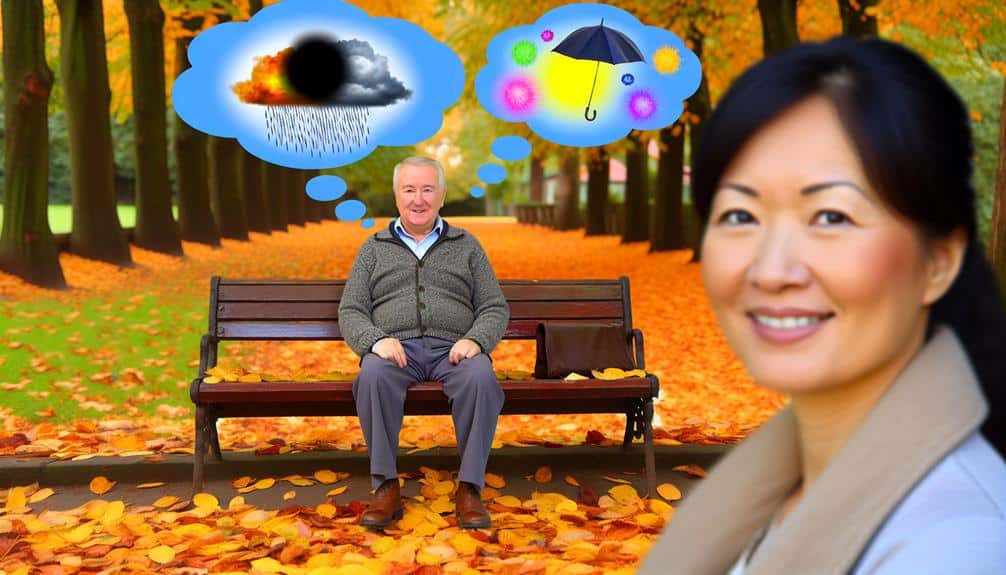Imagine you’re confronted with the inherent, yet deeply challenging, experience of loss in your later years. You’re grappling with intense emotions and perhaps feeling stuck in your grief. Now, consider Cognitive Behavioral Therapy (CBT) as a potential lifeline. This approach doesn’t aim at erasing your loss but equips you with strategies to handle your grief with resilience while promoting healing. Intrigued? Let’s explore how CBT can provide a healthier perspective on loss and effectively support you in this journey.
Table of Contents
ToggleUnderstanding Grief in Later Life

Grief is a natural part of life, but understanding it during your later years can be complex. It’s not just about dealing with the loss of loved ones; it also involves grappling with changes in health, lifestyle, and independence. The grief process during this stage can be uniquely challenging.
You might find that the emotions you experience are more intense or complicated than what you’ve previously felt. It’s not uncommon to feel a profound sense of loss, sadness, or even anger. These emotions aren’t signs of weakness but reflections of the deep love and connections you’ve had throughout your life.
Remember that everyone’s grief process is unique; there is no ‘right’ way to grieve. You might find comfort in sharing your feelings with trusted friends or family members or prefer to process your emotions privately—either approach is valid.
In this journey, know that there are many resources available for elderly support—from bereavement counselors to support groups—that can provide valuable guidance and companionship. Don’t hesitate to reach out; seeking help is a sign of resilience, not defeat. Ultimately, navigating grief in your later years is about honoring your feelings and finding your own path to healing.
The Basics of Cognitive Behavioral Therapy
When diving into the world of Cognitive Behavioral Therapy (CBT), it’s important to understand its foundation. This therapy hinges on the idea that your thoughts, not external events, impact your feelings. It’s not the situation itself but your perception of it that causes your emotional response.
CBT techniques are designed to help you challenge negative thought patterns and replace them with healthier, more positive ones. You’ll learn skills to identify and reframe negative thoughts, ultimately giving you greater control over your emotional reactions.
In the context of grief management, CBT is particularly effective. Grief is a complex emotion—it’s not uncommon for individuals to spiral into negative thoughts and overwhelming sadness. CBT offers a structured approach to navigate through this difficult time.
Remember that CBT isn’t about erasing grief but managing it. It provides tools for coping with loss, enabling you to understand your feelings and respond in a healthier way.
By understanding the basics of CBT, you’re taking the first step towards helping others manage their grief and construct a path towards healing.
Stay tuned for our next topic: “How CBT Addresses Grief”, where we will explore deeper into this therapy’s application.
How CBT Addresses Grief

In the domain of Cognitive Behavioral Therapy (CBT), grief isn’t a monolith but a multifaceted emotional response that can be addressed and managed. As a practitioner, you’ll find that CBT provides a framework for grief processing, allowing you to guide your clients through the complexities of their feelings. This isn’t about suppressing grief but rather learning to navigate it with resilience and understanding.
A pivotal tool in this process is cognitive restructuring. Your role is to help your clients identify and challenge self-defeating thoughts that may amplify their grief. This doesn’t mean denying the pain they’re experiencing but helping them understand that their thoughts aren’t always a reflection of reality.
You’ll work together to replace these thoughts with more balanced ones—a process that can significantly alleviate the burden of grief.
The Role of CBT in Emotional Regulation
By harnessing the power of CBT, you can help your clients gain control over their emotional regulation. As a tool, CBT is especially useful in managing the emotional turmoil that often accompanies grief and loss. It equips individuals with the capacity to recognize, understand, and alter their emotional responses.
Emotional regulation is crucial when coping with grief—it’s about recognizing one’s emotional state, understanding triggers, and developing strategies to manage these emotions effectively. CBT empowers your clients to take control over their emotional responses rather than being consumed by them.
A key component in this process is developing coping strategies—through CBT, clients learn how to challenge thought patterns leading to more balanced emotional reactions. They’re taught how to recognize negative thoughts, evaluate their validity, and replace them with healthier alternatives.
CBT doesn’t promise that grief will disappear; instead, it offers ways for clients to navigate through it—managing their emotional responses—and ultimately, lead a life that’s not dominated by loss. By mastering emotional regulation through CBT, your clients can find a path towards healing and resilience in the face of grief.
Techniques Used in CBT for Grief

Tackling grief head-on, you’ll find a variety of techniques within CBT that can serve as your toolkit. Cognitive restructuring is one such powerful tool—it involves identifying, challenging, and changing irrational or dysfunctional thoughts, beliefs, and attitudes. By reframing these cognitive distortions, you can help individuals navigate the tumultuous waters of grief—enabling them to view their loss from a healthier, more balanced perspective.
The second technique—behavioral activation—is equally important. This strategy encourages individuals to engage in activities they once found enjoyable or meaningful but have since abandoned due to their grief. The aim is to break the cycle of depression and inertia that often accompanies profound loss. By gradually reintroducing these activities into their lives, you can assist individuals in reclaiming their joy and sense of purpose.
These two methods aren’t quick fixes; rather they serve as stepping stones on the path towards healing. By employing cognitive restructuring and behavioral activation techniques—you’re not only addressing symptoms of grief but also fostering resilience—empowering individuals to face their grief head-on while continuing to move forward.
Case Studies: CBT Success Stories
Building upon the techniques of cognitive restructuring and behavioral activation—concrete examples can illuminate the transformative power of CBT when dealing with grief. To illustrate this, let’s explore some CBT case studies.
Consider Jane, a 70-year-old widow struggling with the loss of her husband. Initially, she felt immobilized by her grief—unable to participate in daily activities. Through CBT, Jane learned to challenge her negative thought patterns and replace them with healthier perspectives. She also rediscovered her love for painting—a form of behavioral engagement. As a result, Jane’s grief management improved significantly—demonstrating the effectiveness of CBT.
Then there’s Robert—a retired military officer grappling with the passing of his comrades. CBT helped him identify and alter distorted thoughts about death and loss while behavioral engagement got him involved in community service. This combination of cognitive and behavioral changes led to a notable reduction in his grief symptoms.
The Benefits of CBT for Elderly Individuals

Over time, Cognitive Behavioral Therapy (CBT) has proven to be an incredibly beneficial tool for elderly individuals—particularly those grappling with grief and loss. This method utilizes therapeutic techniques tailored to meet the unique emotional and cognitive needs of older adults. Let’s explore how CBT can greatly enhance elderly support:
- CBT helps individuals recognize and alter negative thought patterns—empowering them to manage emotions more effectively thereby reducing the impact of grief and loss.
- The therapy offers practical strategies that older adults can integrate into their daily lives—improving coping mechanisms.
- By focusing on the present, CBT helps older adults accept their loss and encourages them to move forward.
- CBT also cultivates a sense of self-efficacy—enhancing their confidence and promoting emotional resilience.
Potential Challenges With CBT
While CBT offers a host of benefits for elderly individuals dealing with grief and loss, it’s also important to acknowledge the potential hurdles that might arise during the process. One challenge could be the presence of cognitive distortions—fundamentally inaccurate thoughts—which can obstruct progress. For instance, an older adult might have a distorted belief that they ‘should’ have been able to prevent their loved one’s death—causing guilt and complicating the healing process.
Another challenge lies in developing and implementing effective coping strategies. As individuals age, they may struggle with cognitive flexibility—making it harder for them to adopt new strategies or habits. This doesn’t mean they can’t benefit from CBT; it just might take a little more patience and effort.
Furthermore, older adults might have longstanding resistance to psychological therapy or lack understanding about its purpose and benefits. This can make it difficult for them to fully engage in CBT. It’s vital to approach this with empathy and patience—explaining the purpose, process, and potential benefits of CBT while respecting their feelings and concerns.
How to Find a CBT Therapist

Finding the right Cognitive Behavioral Therapy (CBT) therapist can be a vital step in managing grief and loss in later life. As you navigate through this process, consider the following aspects:
- Therapist qualifications: Look for a licensed professional who specializes in CBT and has experience with grief counseling.
- Location and Accessibility: The therapist’s location should be convenient for you. Also, check if they offer online sessions for added flexibility.
- Comfort Level: You should feel comfortable and at ease with your therapist—this is crucial for maintaining open communication.
- Finding support: Reach out to support groups or online communities for recommendations.
Note that finding a therapist isn’t always a linear process—it may involve some trial and error. However, it’s vital to find a professional who resonates with your needs. Remember, you’re not alone in this journey—there are numerous resources and support networks available to guide you through it.
Patience and persistence will pay off as you work towards finding the right therapist—a partner who can help you navigate the complexities of grief and loss in later life.
Continuing Life After Loss With CBT
Life’s tapestry—once vibrant and full—may seem dimmed after significant loss. You might feel as though a piece of your life has been ripped away, leaving a void that’s difficult to fill. Yet, be assured—it’s within this void that the healing process begins—a journey where Cognitive Behavioral Therapy (CBT) can be a guiding light.
CBT assists in building resilience by teaching strategies to cope with the pain of loss while encouraging positive thinking. It’s not about forgetting your loss; rather, it’s about learning to carry it with you in such a way that doesn’t cripple your ability to function or enjoy life.
This therapy can help you identify and challenge unhelpful thoughts that can lead to feelings of despair. By reframing these thoughts, you can start to view your loss in a more balanced, less distressing way.
It’s about embracing the potential for growth amidst grief and using your loss as a springboard to a life that still holds meaning, joy, and fulfillment.
Understand that it’s okay to grieve but also remember that life continues. With CBT, you’re not alone in this journey.
Conclusion
Sailing through life’s twilight years isn’t without its storms. Yet, like a compass guiding you through rough waters—CBT can help chart a course through grief and loss. It doesn’t erase the storm but strengthens your ship—reframing your thoughts, offering emotional balance, and empowering resilience. The voyage might be challenging—but remember: every journey leads to new horizons. Seek out a CBT therapist and keep your ship sailing—honoring the past while embracing life’s continuous journey.








